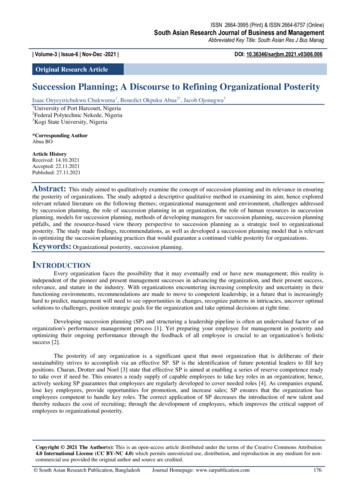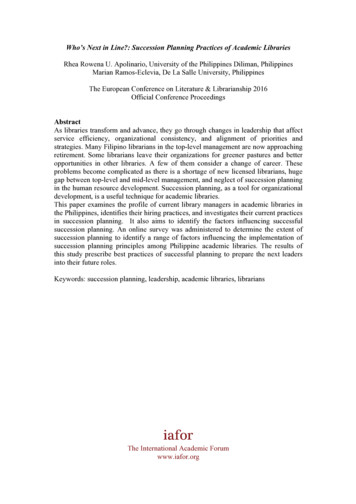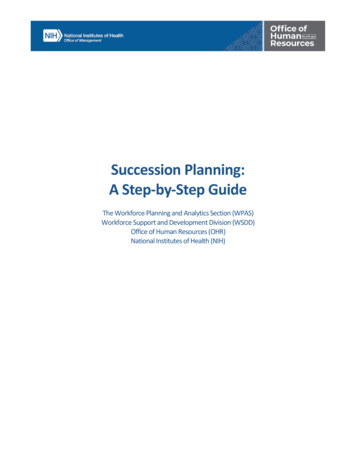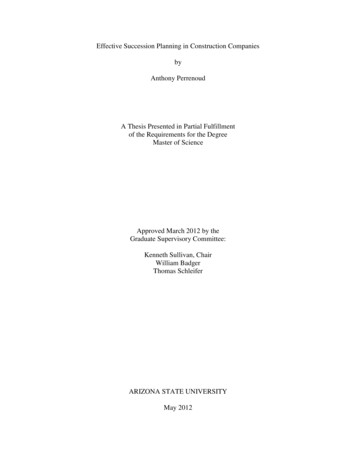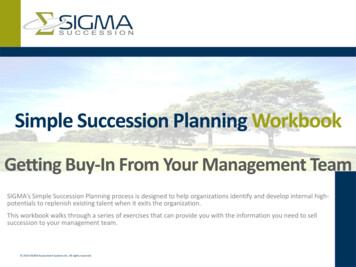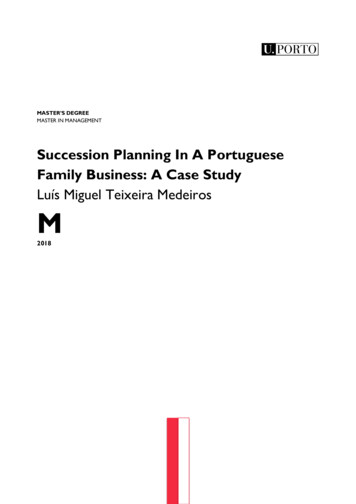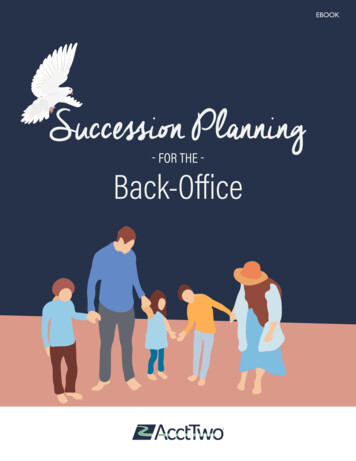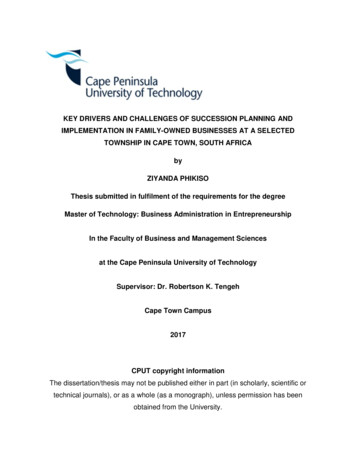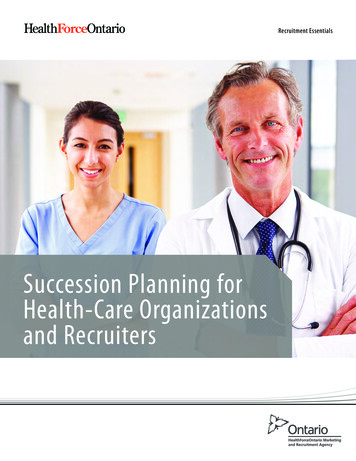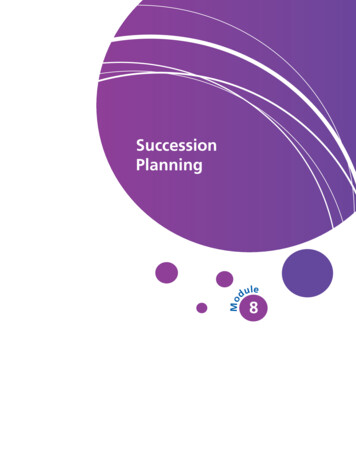
Transcription
MoSuccessionPlanningdule8
CONTENTS8.1Introduction . 4208.2Succession Planning for the Sole Practitioner . 4208.3 Developing Your Succession Plan . 4208.3.1 Understanding Your Firm . 4208.3.2 Your Future Purchaser . 4218.3.3Succession Plan . 4248.4Selecting Your Succession Option . 4258.5Valuation Methodologies . 4268.5.1Introduction . 4268.5.2 Valuation Methods . 4268.68.5.3Capitalization of Future Maintainable Earnings . 4278.5.4Rule of Thumb . 4288.5.5Net Book Value . 428Options for Partnerships, Consolidations, Mergers, and Acquisitions . 4298.6.1 Thinking About Shared Ownership . 4298.78.6.2Partnership/Merger . 4308.6.3Consolidation . 431Sale of Firm, Fee Parcel or Progressive Sell-Down . 4328.7.1Sale of Firm . 4328.7.2Sale of Fee Parcel . 4338.7.3 Progressive Sell-Down . 4348.8 Developing Internal Succession Plans . 4358.8.1 Internal Succession . 4358.8.2 Admission of New Partners . 4368.8.38.9Buyout by Existing Partners . 436Exit Considerations . 4378.9.1 Taxation Implications . 4378.9.2 Constraints of Trade . 4378.9.3Lifestyle Changes . 4388.9.4Compliance Issues . 438418
8.10Conclusion . 4388.11 Further Reading and IFAC Resources . 439Appendix 8.1 Partnership/Merger Checklist . 440Appendix 8.2 Consolidation Checklist . 442Appendix 8.3 Sale of Firm Checklist . 443Appendix 8.4 Sale of Fee Parcel Checklist . 444Appendix 8.5 Progressive Sell-Down Checklist . 445Appendix 8.6 Internal Succession Checklist . 446Appendix 8.7 Admission of New Partners Checklist . 447Appendix 8.8 Buyout by Existing Partners Checklist . 448Appendix 8.9 Compliance Issues Checklist . 449Appendix 8.10 Case Study . 451419
Module 8: Succession Planning8.1IntroductionAs professional accountants grow older, their thoughts inevitably turn to their exit—not only from the firm,but from practicing accountancy altogether. As they consider their departure from business life, they wonderif the firm they have built up will have value in someone else’s eyes.It has provided them with an income stream over the years, and allowed them to serve the community.They have built relationships with clients over this time, helped them, served them and supported them.Yet the question remains, will the firm be worth anything to anyone else? And if so, how much and towhom?A succession plan allows for the orderly exit of the practitioner. This means it is not left to chance, and thereis a plan in place. This gives a degree of comfort to those involved, particularly staff.This module considers these questions and many more. Its objective is to assist you in coming to terms withthe issues you need to consider and to help you get “succession-ready.”8.2Succession Planning for the Sole PractitionerThe number of issues currently facing the profession has been well documented and covered in previousmodules. These include:··The aging of the profession;··Trouble attracting and retaining staff;··Compliance and regulatory pressures;··Time pressures on sole practitioners; and··Client requirements at a high level, which means practitioners have little time to focus on theirsuccession plan requirements.In addition, a large percentage of accounting firms are one- to two-partner firms. This is what the practitionerswanted, but many sole practitioners will need to consider taking on partners as part of their succession plan.Many will find this difficult, as they will have been on their own for many years. This may seem contrary tothe whole philosophy of operating as a sole practitioner.If anything, this highlights the fact that the sooner the succession plan is underway, the sooner these issuescan be dealt with.This module provides checklists and resources to assist in this process. In this module, the term “successionplanning” is used essentially in the context of firm exit.8.3Developing Your Succession PlanOne of the most common questions asked by practitioners as they begin to consider succession planningis, “Will someone pay me for this firm?” The answer is usually “Yes,” but the answer to the question, “Howmuch?” depends on a number of factors.8.3.1Understanding Your FirmOne of the best ways to enhance the value you realize on exit is to plan for it in a structured manner. Table 8.1sets out pertinent considerations for those thinking of retiring. The answers to these questions will helpyou determine the approach you should take with your succession, and also help you assess which of thepotential options you should consider.420
Module 8: Succession PlanningTable 8.1 Understanding you and your firm betterQuestionResponse/Action1.What options do I have?2.What needs to be done to make it all happen?3.What would I like to see happen to my clients?4.What would I like to see happen to my staff?5.What restraints of trade will I find acceptable?6.When should I start talking to potential purchasers/partners?7.How much do I think my firm is worth?8.How much is my firm really worth?9.How much money do I want to exit with?10.Do I enjoy working with others, or prefer working onmy own?11.How long will I need to stay involved in the firm afterI sell my interest?12.Whom should I start talking to about buying myinterest?13.Are any of my staff potential purchasers?14.How profitable is my firm?15.What systems, procedures and processes do I need toput in place to enhance the performance of my firm?16.Would my firm represent a worthwhile investment tosomeone else?Once you have answered these questions, you need to review the rest of this module to gain an understandingof the succession options available. This module discusses eight such options in detail. At least one ofthese will stand out to you as the preferred option. You should plan to position your firm in such a way as tomaximize the return you can achieve by pursuing that option.8.3.2Your Future PurchaserWhichever option you choose, if you plan to sell one day, you must always be mindful of your futurepurchaser. Your future purchaser will need to have the following questions satisfied:··Is this a good investment?··Will it provide me with a good return on my investment?··Does it represent good value?421
Module 8: Succession PlanningThe first step in succession planning is to get your firm “succession-ready.” The best way to do this is toconsider the questions a potential purchaser, or future partner will ask. You should then develop your firmin such a manner as to be able to give strong, positive answers to these questions.A purchaser will typically assess their purchase against the criteria shown in Table 8.2.Table 8.2 Purchaser considerationsAreaLevelAnalysisFeesHistory of fee levelsWhat have fees been over the last one, three, andfive years?Calculate and assess growth over these years.Maintainability of feesWill fees be maintained?Is there evidence of sustainable cash flows?What evidence exists to support this?Impact of non-recurring Identify non-recurring fees.feesAssess impact on expected future maintainablefees.ProfitabilityHistory of profitsIdentify profits over last one, three, and five years.Maintainability of profits Will profit levels be maintained?What impact will the succession event have onprofits?Impact of non-recurring Identify non-recurring profit component.fees on profitsAssess as to impact on recurring profit.“Add backs” of nonoperating expensesIdentify non-business expenses.Add back non-operating expenses to assessoperating profitability from a business perspective.Items may include excessive wages to owner,travel and accommodation, utilities.Assess normalized profit against purchase criteria.DebtorsDebtors positionReview debtors.Review and assess bad debts.What are current levels of bad debtwrite-offs?What are expectations for future?422Response
Module 8: Succession PlanningAreaLevelAnalysisResponseDebtors control process Identify current debtors control process.Identify collections history.Assess effectiveness.Work inprogress (WIP)WIP positionAdjust asappropriate.Review WIP.Assess WIP and likelihood of converting to feesand collection.What are current levels of write-offs andexpectations for future?WIP control processIdentify current WIP control process.Assess effectivenessClient baseStability of client baseAssess client numbers over last three years.Check number of clients acquired over last threeyears.Check number of clients lost over last three years.Spread of clientsCheck spread of clients across industry sectors.Check size of clients; that is, turnover, number ofemployees, etc.Age of business owners Check age of business owners in client base. Ifin client baseclose to retirement age, this will likely have animpact on future earnings of firm.DependencyStaffClientsCheck for dependence on any one client, or fewclients.IndustryCheck for dependence on any one industry, or fewindustries.PractitionerCheck for dependence on existing practitioner,from both clients and staff.Quality of existing staffAssess for competence and ability.Assess qualifications and experience.Review and assess billings history.SystemsInternal infrastructureAssess internal infrastructure, processes, systems,quality control procedures.423Adjust asappropriate.
Module 8: Succession PlanningAreaLevelAnalysisComplianceGovernment regulatorIdentify any outstanding issues.ResponseAssess impact on new owners.Government taxdepartmentIdentify any outstanding issues.Assess as to impact on new owners.WeightingValue of top five clientsas percent of fee baseIdentify top five clients.Determine their fees.Total these and calculate as a percentage offee base.TransitionHandover processWhat is the “handover” process?How long is vendor prepared to stay for handover?Look for planned approach, which should include:Strategy for handover;Strategy for communicating with key clients,e.g. meetings to be held with each;Communication strategy for balance of client base;Strategy for communicating with existing staff,e.g., team meeting; andTraining on systems and procedures.RestraintAssess restraint of trade conditions.Assess non-compete issues.Ethical8.3.3Assess as to existence of ethical issues withinclient base which may impact on ethical positionof firm.Succession PlanWhichever succession option you choose, your firm may need to improve its financial position to be a moreattractive investment option for potential purchasers.There are typically a number of key areas in which a firm can improve and which will have a positiveimpact on financial performance. It is important that these improvements have been implemented and areingrained in the firm before putting the firm up for sale.Key areas for firm assessment include:··Revenues;··Profitability;424
Module 8: Succession Planning··Liquidity;··Debtor control;··Work in progress control; and··Growth.Other modules discuss approaches to improving these areas.8.4 Selecting Your Succession OptionIt is important to consider which succession option is most naturally attractive to you and which you thinkwill maximize your final settlement amount. There are three to choose from.··The first is joining with others and becoming larger. This ensures you have others who are in a positionto buy you out. These options are covered in Section 8.6, and include partnership, consolidation, andmerger alternatives.··The second is selling off the firm, whether in total, or selling a fee parcel at a time, or on a progressivesell-down basis. These options are considered in Section 8.7.··The third is a series of internal options, which are covered in Section 8.8 and include internalsuccession, the introduction of new partners and sale to existing partners.Each option is quite distinct and brings its own set of considerations. As Table 8.3 shows, a number ofissues apply to each.Table 8.3 Issues to consider when selecting your succession option1.IssueCommentPlanningSet date for completion.ResponseDiscuss with key stakeholders.Identify checklists to complete.2.TaxationConsider tax implications of alternative options.Identify any reorganization of entity structuresrequired.Put in place new structures within time framerequirements.3.FundingConsider funding requirements for your exit.Organize financial arrangements as required.Introduce topic of funding early in discussions withpotential purchasers to ensure capacity.4.ExitConsider full impact of your exit from the firm.Consider strategies to ensure minimal disruption toongoing firm performance.Implement strategies to ensure effective handoveron your final exit.425
Module 8: Succession Planning8.58.5.1Valuation MethodologiesIntroductionThe valuation of your firm is an important step in your succession plan. If one of your objectives is tomaximize the amount you receive at settlement when you leave, you should focus on ensuring that thisvaluation is as high as possible. By understanding the component parts of the valuation methodology, youcan concentrate on those areas that need to improve.It is well established that valuation is more of an art than an exact science, albeit with sound methodologybehind it. It is also important to be clear on the definition of the actual valuation. The technical definitionwould be, “The fair market value is the price that would be negotiated in an open market between aknowledgeable, willing but not anxious buyer and a knowledgeable, willing but not anxious seller dealingat arm’s length.” This would correctly establish the fair market value, but may be different from the amountwhich is finally paid.There can be many reasons for this, including external factors beyond the control of the parties. Thesewould include factors such as the economic climate, interest rates and the supply and demand of firms forsale at that particular time.It may also include other factors over which the parties do have control, such as the state of readiness thefirm is in at the time of sale, the internal systems and procedures, the level and capability of staff, or thefinancial position of either the vendor or purchaser.Value is usually a function of profitability multiplied by a “multiple,” where the multiple takes into accountgrowth prospects, risk, quality of earnings, and other factors discussed throughout this module. However,it is also wise to consider the synergistic benefits available to potential purchasers. This could be theelimination of a competitor, opening a new market, or adding fees to an existing cost base.To maximize value, it is important to recognize such factors and incorporate them into your strategy for thefuture sale of the firm. At the same time, it is important to acknowledge the areas over which you do havecontrol, and put strategies in place to improve these.It may take a number of years for these strategies to have an impact on the value of the firm, whichhighlights the need to start the succession process early.8.5.2Valuation MethodsThe traditional methods used in business valuation include:··Capitalization of future maintainable earnings; ··Rule of thumb, or industry method; ····value is based on expected future earnings, relative to the risk return expected, where acapitalization rate, or multiple, is applied against an estimate of future maintainable earnings,value is based on an “industry standard” applied to each firm, with the value expressed interms of a multiplier, or cents in the dollar.Net book value; value is simply based on the net book value of the assets of the firm. value is based on estimated future cash flows discounted to give their present values, wherethe discount rate used reflects the risk of the expected future.Discounted cash flow426
Module 8: Succession PlanningThe most commonly used method is the capitalization of future maintainable earnings method, followedby the rule of thumb method. Where partnership agreements are in place, the agreement would normallynominate the valuation formula to be applied and identify certain key components, such as number of years’earnings to be included and capitalization rate to be used.8.5.3Capitalization of Future Maintainable EarningsThis is a widely used method for valuing accounting firms.This methodology seeks to determine the current value based on expected future earnings, relative to therisk return expected.There are two key elements in this model.The capitalization rate is the rate that will be applied to the earnings to determine the value. It is essentiallyan application of the price/earnings ratio. It is not a precise figure that can be applied universally, aseach situation will be different. However, it is often within a range that takes into account the particularcircumstances of a case.Future maintainable earnings is an estimate of the earnings the firm will generate on a maintainable basisinto the future. Earnings from the recent past are taken as a guide. Traditional accounting firms with astrong audit or compliance base tend to have a high level of recurring income. This provides them withstrong earnings potential, as their clients come back year after year.Other factors that will impact earnings need to be taken into account, such as the loss of a key client, orthe introduction of new services. Also, non-recurring income is identified and removed from the calculation.This approach can be expressed as a formula:Future maintainable earningsValuation Capitalization rate8.5.3aCapitalization RateThe capitalization rate is essentially the return on investment that the valuer expects from that particularinvestment. Factors to consider include:··The current “risk free” rate of return available in the market, usually the government bond rate;··Bank interest rates;··Price earnings ratios of publicly listed shares;··Ability to re-sell the firm, supply of ready buyers;··Industry and business risks;··Length of time the firm has been operating;··Impact of technology on the firm;··Where the firm is in its business life cycle;··Dependency on clients, staff, or practitioner;··Impact of any regulation changes; and··Comparative rate used in comparative firm sales.427
Module 8: Succession PlanningThe starting point is the risk-free rate, which is then adjusted according to consideration of factors influencingthe rate, such as those listed above. A common way to express the capitalization rate is to invert it and referto it as the “multiple.” That is, 1/Capitalization Rate is the multiplier.8.5.3bDiscounted Cash FlowDiscounted cash flow is a valuation approach that determines what someone is willing to pay today in orderto receive the anticipated cash flow in future years. Essentially it means converting future earnings intotoday’s money. The future cash flows are discounted in order to express their present values to properlydetermine the value of the investment under consideration.The discounted cash flow or DCF approach describes a method of valuing an investment using the conceptsof the time value of money. All future cash flows are estimated and discounted to give their present values.The discount rate used is generally the appropriate weighted average cost of capital that reflect the risk ofthe expected future cash flows. The discount rate reflects two things:··The time value of money. Investors would rather have cash immediately than have to wait; therefore,they must be compensated by paying for the delay.··The risk premium. This reflects the extra return investors demand because they want to becompensated for the risk that the cash flow might not materialize after all.The DCF for the purchase of an accounting firm is calculated by estimating the investment you willhave to make at the start and the return you think you will receive. The timing for when you expect toreceive the payments also needs to be estimated. Each transaction then needs to be discounted by theopportunity cost of capital over time between now and when you expect to receive the return on yourinvestments.8.5.4Rule of ThumbThe rule of thumb valuation method applies an “industry standard” to each business within that industry. Itis typically expressed in terms of a multiplier, or cents in the dollar. It is applied to either the net earnings ofthe business, that is, earnings before interest and tax (EBIT), or to its turnover.For instance, accounting firms may apply a certain level of cents in the dollar to their gross fees. Thisvaluation method is popular for smaller firms, where other factors affect the valuation decision. Likelypurchasers of fees at this level are sole practitioners looking to enter business at a low fee level. Essentially,they want to “buy a job,” and are prepared to pay a higher price for the fees than the price point at whichtraditional methods would value them.If there is a high reliance on low-value work, such as income tax return preparation, they tend to be towardthe lower end of this price range. If there is a strong recurring base of business client work, it tends to be atthe higher end of the price range.The main drawback to adopting the rule of thumb approach is that it assumes all firms are run and managedin the same way. It assumes clients interact the same way and pay their bills in similar ways, and the coststructure of the firm is the same. Clearly this will not be the case, but even so, this method is fairly widelyused. The main reason is its simplicity; it is also widely understood.8.5.5Net Book ValueThe net book value valuation method is used where there is unreliable profit and loss information or wherethe business being valued is trading at a loss. If it is trading at a loss, the future maintainable earningmethod cannot be applied.428
Module 8: Succession PlanningThis method may be appropriate in situations where vendor and purchaser agree that there is somevalue in the firm but that this will not be realized from future earnings. The value is essentially held inthe balance sheet, and both parties agree to accept that as the starting point. It is mostly used in thosesituations where the firm is asset rich but earnings poor.In such situations, it is advisable to engage an independent valuer for the assets of the business, becausethe assets are likely to be stated at historic cost value, and depreciation is likely to be charged at taxrates, not useful life. The written-down book value may be quite different from the market value in suchcases.8.6Options for Partnerships, Consolidations, Mergers, and AcquisitionsOne succession pathway is to join others and become larger. This may allow the practitioner to become amore attractive investment target, or provide a ready pool of fellow partners who are in a position to buy outthe practitioner. There are a number of structures to consider.1. PartnershipTwo or more people carry on business in common with a view to a profit. Rules relating to partnershipsinclude joint ownership, participation in gross returns, sharing of profits and losses, and the exercise ofpartners’ rights. One of the key issues in a partnership is joint and several liabilities of all partners; this willbe subject to your country’s laws or professional regulations.2. ConsolidationA larger company purchases a number of smaller firms and “consolidates” them into one larger entity,seeking to achieve operating efficiencies and cost savings. The consideration is usually a combinationof cash and shares in the larger company. The shares in the larger company are typically held in escrowand cannot be sold until a prescribed time period has elapsed. Consolidators are typically structured ina corporate model, with external investors, board of directors, chief executive officer and managementteam.3. MergerTwo firms combine to make one larger firm. It works best when the two firms are of similar size; otherwiseit tends to be more of a takeover. The equity of each partner in the combined firm is typically based on theproportionate value of the fees going in.As you can see, there is a common thread running through each of these structures: the coming together ofexisting businesses and structures. Note that the issues involved in working with others in joint ownershipare quite different from issues relating to the sale of a firm, or the sale of fee parcels, which are coveredlater. As such, there are a large number of issues common to partnerships, consolidations and mergers,which need to be considered prior to the actual event.8.6.1Thinking About Shared OwnershipFor many sole practitioners, the idea of sharing the ownership of their firm is contrary to the philosophyof their professional careers. Some may have been involved in or worked in partnerships previously anddecided it was not for them. Others may simply have decided to be on their own from the start. One thingis certain: being involved in a partnership, consolidation or merged firm is distinctly different from being asole practitioner.Accordingly, prior to becoming involved in such structures, the practitioner should self-assess their aptitudeand carefully consider the questions in Table 8.4.429
Module 8: Succession PlanningTable 8.4 Self-assessment questionnaire for those considering partnership, consolidation or mergerQuestionResponse Comment1.Do I really want to share decision-making, control, andprofits with others?2.What am I really getting myself involved in?3.Do I want to share ownership of the firm?4.Does the upside of shared ownership outweigh thedownside?5.Can I trust my partners?6.Will they work as hard as I do?7.How much money will I make?8.Will I make more in the new structure, or less?9.What are the key reasons I am doing this?10.Have I considered the advantages and disadvantages ofeach? What are they?If you have decided that this is the most suitable succession pathway, it is important to consider each optionin greater detail.8.6.2 Partnership/MergerIn the context of succession, there are two important steps in the partnership or merger process. The first isthe challenge of the partnership or merger itself. The second is the exit of the practitioner. Remember thatthe main reason for choosing this option is to enable your exit from the firm.It is important that all partners have a clear understanding of this from the outset and clear expectations. Itis essential that the partnership agreement takes this into account and documents how and when the exitis to occur. The partnership agreement should also deal with valuation issues. Th
Module 8: Succession Planning 422 The first step in succession planning is to get your firm "succession-ready." The best way to do this is to consider the questions a potential purchaser, or future partner will ask. You should then develop your firm in such a manner as to be able to give strong, positive answers to these questions.
